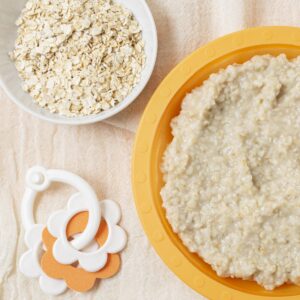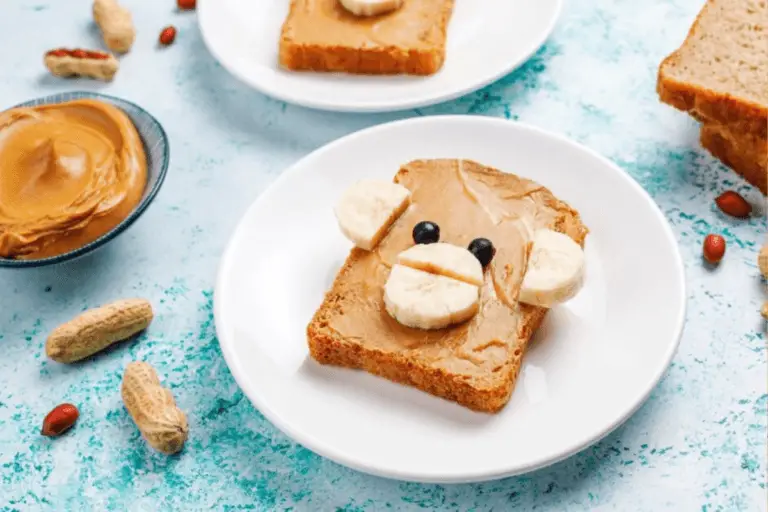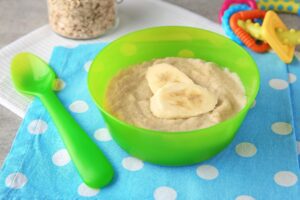Banana bread is a beloved baked treat, popular for its rich flavor, moist texture, and versatility. But when it comes to babies, parents often wonder if this sweet bread is appropriate for their little ones. Integrating banana bread into a baby’s diet can be a delightful experience, offering a soft, flavorful, and nutritious option. Introducing banana bread to baby can be a lovely way to expand their diet with a nutritious and flavorful option. Smooth and easy to eat, when prepared with baby-friendly ingredients, banana bread is a safe and enjoyable treat for little ones. This guide will walk you through the best practices, recipes, and safety tips for adding banana bread to your baby’s meals.
Understanding Banana Bread Basics
Banana bread is a quick bread made from ripe bananas, flour, sugar, eggs, and baking agents like baking soda. Its soft and crumbly texture appeals to people of all ages. You can easily modify the basic recipe to suit specific dietary needs by reducing sugar or using gluten-free alternatives.
For babies, traditional banana bread recipes often require adjustment to avoid added sugars and potential allergens. By tailoring the recipe, you can create a version of banana bread that’s nutritious and safe for infants while preserving its delicious flavor. Knowing the fundamentals of banana bread preparation helps parents make informed choices when introducing this treat to their little ones.
When Can Babies Eat Banana Bread?
Babies can typically try banana bread once they’ve started solids, usually around six months of age. However, it’s crucial to ensure the bread is free from added sugar, salt, and other potentially harmful ingredients. The texture of banana bread to baby needs should also match their developmental stage. They should opt for a very soft, mashed, or crumbly consistency that is easy to gum and swallow.
Consult your pediatrician before introducing banana bread, mainly if it contains eggs, dairy, or nuts, which are common allergens. If your baby is new to solids, start with simple ingredients like mashed bananas before offering a baked version. Watch for any signs of food allergies or intolerances during the first few introductions.
Nutritional Benefits of Banana Bread
When made appropriately, banana bread can provide several nutritional benefits for babies. Ripe bananas are rich in natural sugars, potassium, and dietary fiber, making them a great energy source and helpful for digestion. When prepared with whole-grain or oat flour, banana bread contributes valuable nutrients like B vitamins and complex carbohydrates.
Suppose you include eggs and milk in the recipe. In that case, your baby will gain additional protein and calcium for muscle development and bone growth. Adding extras like ground flaxseeds or chia seeds can further enhance the bread’s omega-3 fatty acid content. However, to maximize benefits, minimizing or eliminating added sugars, fats, and processed ingredients is essential.
How to Make Banana Bread for Babies
Creating a baby-friendly version of banana bread involves using simple, wholesome ingredients and avoiding unnecessary additives. Here’s a basic recipe you can try:

Ingredients:
- 2 ripe bananas (mashed)
- 1 cup oat or whole-grain flour
- 1 egg (optional, depending on age and allergies)
- 1/4 cup unsweetened applesauce
- 1/2 tsp baking soda
- A pinch of cinnamon (optional)
Instructions:
- Preheat the oven to 350°F (175°C).
- Mix the mashed bananas, applesauce, and egg in a bowl until well combined.
- Add the flour, baking soda, and cinnamon, and gently mix to form a smooth batter.
- Pour the batter into a greased loaf pan.
- Bake for 25–30 minutes or until a toothpick inserted into the center comes out clean.
- Let cool before serving small, soft pieces to your baby.
By focusing on natural sweetness and whole ingredients, this version of banana bread is ideal for babies.
Safety Considerations
safety should be a top priority. Begin by offering very small portions to ensure they can handle the texture. Avoid including potential allergens such as nuts or dairy if your baby hasn’t yet been introduced to these foods. Monitor your baby during feeding to prevent choking, particularly if the bread contains small pieces or is overly dense.
Additionally, always check the ingredients list for any hidden additives if purchasing banana bread from a store or bakery. Homemade versions are generally safer and more customizable to your baby’s needs. Finally, practice proper food hygiene, storing leftovers in an airtight container and discarding them after a day or two to prevent spoilage.
By understanding the basics, nutritional benefits, and safety considerations, you can confidently introduce banana bread to your baby’s diet. With a few adjustments, this classic treat can become a wholesome addition to your baby’s growing palate.
Enhancing Banana Bread for Babies
Making banana bread for babies provides an opportunity to enhance its nutritional value by including ingredients that support their growth. Substituting refined flour with whole-grain or oat flour increases fiber and essential nutrients. Incorporating mashed vegetables like sweet potatoes or pureed carrots adds vitamins and minerals, while ingredients like ground flaxseeds or chia seeds can supply omega-3 fatty acids.
Reducing or eliminating sugar is crucial when preparing banana bread to baby standards. Natural sweetness from ripe bananas and unsweetened applesauce is sufficient for young taste buds. Additionally, using unsaturated oils like olive oil or skipping butter can make the bread heart-healthier. By focusing on wholesome, baby-friendly ingredients, you can transform traditional banana bread into a nutritious snack suitable for your little one’s dietary needs.
Common Mistakes Parents Make
Introducing banana bread to baby diets is exciting, but parents sometimes make mistakes that hinder its safety or nutrition. One standard error is using recipes that include sugar or salt, which are not recommended for babies under 12 months. Additionally, adding nuts, seeds, or dried fruits without modifying their size can pose a choking hazard.
Another frequent oversight is offering banana bread before ensuring the baby is ready for textured foods. This can lead to difficulties in chewing or swallowing. Parents should also avoid serving large portions, as banana bread should complement meals rather than replace them. By being mindful of these pitfalls, parents can ensure that banana bread is a safe and beneficial treat for their baby.
The Role of Banana Bread in Baby’s Diet
Banana bread can be a versatile addition to your baby’s diet, offering a mix of flavors and nutrients that support growth and development. Its soft texture makes it an excellent choice for babies transitioning to solid foods. With the right recipe, banana bread for baby meals can provide essential vitamins, such as vitamin C and potassium, which are abundant in bananas.
While banana bread is nutritious, it should not replace primary sources of nourishment like breast milk, formula, or balanced meals. Instead, it can be a healthy snack or part of breakfast paired with fruits or yogurt. Parents can experiment with minor adjustments to the recipe to match their baby’s nutritional needs and preferences, ensuring a balanced diet.
Cultural Variations and Banana Bread
Banana bread is a beloved treat worldwide, but its preparation varies across cultures. In some regions, banana bread is infused with spices like cardamom or nutmeg. In contrast, others incorporate local ingredients like coconut or plantains. Understanding these variations can inspire parents to introduce diverse flavors to their baby’s palate.
When adapting cultural banana bread recipes to baby diets, modifying ingredients for safety and nutrition is essential. For example, Jamaican-style banana bread often includes rum and sugar, which should be omitted for baby-friendly versions. Exploring these cultural twists adds variety and helps expand your baby’s taste preferences from an early age.
Introducing banana bread to baby can be a delightful way to add variety to their diet. This soft, flavorful treat offers nutritional benefits when prepared with wholesome, baby-friendly ingredients. Learn how to safely and healthily incorporate banana bread into your baby’s meals.
FAQs
1. Can babies eat store-bought banana bread?
It’s better to avoid store-bought banana bread for babies, as it often contains added sugars, preservatives, and other ingredients unsuitable for infants. Homemade banana bread is a safer option.
2. What is the best age to introduce banana bread to baby diets?
Banana bread can typically be introduced around six months. Still, the recipe should be tailored to include baby-friendly ingredients and an appropriate texture.
3. Can I freeze banana bread for my baby?
Yes, freezing is an excellent way to preserve baby-friendly banana bread. Cut it into small portions, wrap them individually, and store them in an airtight container for up to three months.
4. Should banana bread contain eggs for babies?
Eggs are a good source of protein and nutrients, but if your baby hasn’t been introduced to eggs yet, it’s best to consult your pediatrician first. You can substitute eggs with alternatives like mashed flaxseeds if necessary.
5. How much banana bread can my baby eat?
Portion sizes should be small, as banana bread is meant to complement meals. A piece the size of your baby’s palm is usually sufficient for a snack.
6. Can banana bread be a meal replacement for babies?
FAQs
No, banana bread should not replace meals for babies. It is best served as a snack or an accompaniment to a balanced meal. Primary nutrition should come from breast milk, formula, or a well-rounded diet of fruits, vegetables, proteins, and grains. Banana bread can complement these foods but lacks the comprehensive nutrients needed for a baby’s main meals.
7. Is it safe to add spices to banana bread for babies?
Yes, mild spices like cinnamon or nutmeg can be added to enhance flavor. However, always introduce spices one at a time to watch for any adverse reactions. Avoid strong or spicy seasonings like chili or ginger, which might upset your baby’s stomach.
8. Can I include nuts in banana bread for babies?
Whole nuts and large chunks of nuts are choking hazards for babies. Grind nuts into a fine powder, or use nut butter to add nuts. Always introduce nuts separately beforehand to ensure your baby has no allergies.
9. What sweeteners are safe for babies in banana bread?
For babies under one-year-old, it’s best to avoid any added sweeteners, including sugar, honey (due to the risk of botulism), or artificial sweeteners. Ripe bananas and unsweetened applesauce provide sufficient natural sweetness for baby-friendly banana bread.
10. Can I use gluten-free flour in banana bread for babies?
Yes, gluten-free flour such as oat, almond, or coconut flour can make banana bread suitable for babies with gluten sensitivity or celiac disease. Ensure the flour is fresh, and avoid processed gluten-free mixes with added ingredients.
11. Is banana bread suitable for teething babies?
Soft banana bread can be soothing for teething babies when served cold. The texture is easy to gum and can be chilled to provide additional relief for sore gums.
12. How should I store banana bread for my baby?
Banana bread can be stored in an airtight container at room temperature for up to 2 days. For more extended storage, refrigerate for up to a week or freeze individual portions for up to three months. Always check for spoilage before serving.
Conclusion
Banana bread can be a delightful and nutritious addition to your baby’s diet when prepared thoughtfully. By focusing on baby-friendly recipes, avoiding common mistakes, and exploring creative ways to enhance its nutritional value, parents can confidently introduce banana bread to baby meals. Whether as a snack, part of breakfast, or a travel-friendly food option, banana bread offers versatility and flavor that suits babies’ developing palates.
Remember, homemade recipes tailored to your baby’s needs ensure maximum safety and nutrition. With a little effort, banana bread can become a favorite treat for your baby while supporting their growth and fostering a love for healthy foods.
Print
Banana Bread for Babies: A Safe and Nutritious Treat
- Prep Time: 10 minutes
- Cook Time: 25–30 minutes
- Total Time: 35–40 minutes
- Yield: 1 small loaf (approximately 8 baby-sized portions)
- Category: Baby Food, Snack
- Method: Baking
- Cuisine: International
- Diet: Vegetarian
Description
This banana bread recipe for kids is designed to be simple, nutritious and safe. It uses natural ingredients like ripe bananas and sugar-free applesauce to provide natural sweetness without the addition of refined sugars. It is easy to make and is suitable for the needs of little ones, offering a soft texture and healthy ingredients that support their growth. Perfect as a snack or complement to breakfast!
Ingredients
Ingredients for Banana Bread for Kids
Here is a basic recipe for making healthy, kid-friendly banana bread:
- 2 ripe bananas (mashed)
- 1 cup whole wheat flour or oatmeal
- 1 egg (optional, depending on the child’s age and allergies)
- 1/4 cup sugar-free applesauce
- 1/2 teaspoon baking soda
- A pinch of cinnamon (optional, for added flavor)
This combination of natural ingredients ensures that banana bread is nutritious and easy for children to digest.
Instructions
Instructions for Making Banana Bread for Kids
Oven Preparation:
Preheat oven to 350°F (175°C). Lightly grease a loaf pan or line it with parchment paper.Mash the bananas:
In a large bowl, mash the ripe bananas until smooth.Combine wet ingredients:
Add applesauce and egg (if using) to the mashed bananas. Mix well until combined.Add the dry ingredients:
Stir in the flour, baking soda, and cinnamon (if desired). Mix gently until combined, without overworking the dough.Pour the batter into the pan:
Pour the batter into the prepared pan, spreading it evenly.Bake:
Bake for 25–30 minutes or until a toothpick inserted into the center comes out clean.Cool and serve:
Let the banana bread cool in the pan for about 10 minutes, then transfer to a wire rack to cool completely. Cut into small, soft pieces and serve to your baby.
Suggestions:
Store leftovers in an airtight container in the refrigerator for up to 3 days.
You can freeze small portions for later use: wrap them individually and store them for up to 3 months.
Notes
Notes for Banana Bread for Babies
Use fresh, natural ingredients like ripe bananas and whole-grain or oat flour. Avoid added sugar, sweeteners, and honey (not safe for babies under 12 months).
Introduce allergens (e.g., eggs, dairy) individually before adding them to the recipe.
Adjust texture: for younger babies, mash or serve in small, soft pieces to avoid choking.
Store leftovers in an airtight container in the fridge for up to 3 days or freeze portions for 3 months.
Monitor your baby during meals and avoid hard or large pieces.
Serve as a snack, not a meal replacement, to maintain a balanced diet.
Nutrition
- Serving Size: 1 no
- Calories: 70–80 kcal
- Sugar: 3–4 g
- Sodium: 10–15 mg
- Fat: 1.5–2 g
- Saturated Fat: 0.5 g
- Unsaturated Fat: 1–1.5 g
- Trans Fat: 0 g
- Carbohydrates: 14–16 g
- Fiber: 1.5–2 g
- Protein: 1.5–2 g
- Cholesterol: 10–15 mg


